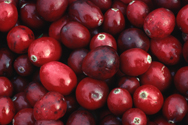 |
Cranberry
Vaccinium macrocarpon
Family: Ericaceae
CTFA name: Vaccinium Macrocarpon (Cranberry) Fruit Extract |
Return to herb list |

Photo © Steven Foster
Introduction
Also known as “low-bush cranberry”, Vaccinium macrocarpon is a trailing, evergreen, slender-stemmed shrub with leathery leaves, white to pink flowers, and glossy red, tart flavored fruit. Native to North America, the plant is also grown in northern and central Europe. A juice is produced from the fruit and is extensively marketed in the United States, with Massachusetts as the major producer.1 History and Cultural Significance
The Iroquois and the Cherokee tribes viewed the cranberry as a symbol of peace and friendship.2 Historically, cranberries were used by American settlers in poultices for treating wounds and blood poisoning, and were eaten to prevent scurvy (a disease caused by Vitamin C deficiency). Cranberries and their leaves were used for treating various conditions including stomach ailments, liver problems, fever, swollen glands, and mumps.2 Traditionally, the fruit has also been used to treat urinary tract infections2 and as a urinary deodorizer for people with incontinence.3 In foods, cranberries are used widely in fruit juice, jelly, and sauce. Modern Research
A number of clinical studies in recent years have shown positive outcomes for the use of cranberry juice and its extract for urinary tract health.4,5,6,7 Future Outlook
For a time overproduction diminished the price of cranberries.8 Due to its health benefits, cranberry has attracted widespread media and industry attention in recent years. Moving from beverages and mineral waters into dairy and confectionary products, cranberry is now recognized as a key ingredient in the supplement market.9 Because of the increased awareness of the importance of healthy nutrition, the future of cranberries appears to be assured. References
1 Leung AY, Foster S. Encyclopedia of Common Natural Ingredients 2nd ed. New York: Wiley Inter-Science Publication. 1996. 2 Blumenthal M, Hall T, Goldberg A, Kunz T, Dinda K, Brinckmann J, et al, eds. The ABC Clinical Guide to Herbs. Austin, TX: American Botanical Council; 2003. 3 Jellin JM, Gregory PJ, Batz F, Hitchens, K, et al. Pharmacist’s Letter/Prescriber’s Letter Natural Medicines Comprehensive Database 5th ed. Stockton, CA: Therapeutic Research Faculty; 2003. 4 Avorn J, Monane M, Gurwitz J, et al. Reduction of bacteriuria and pyruria after ingestion of cranberry juice. JAMA 1994;27(11):751-754. 5 Yarnell E. Botanical medicine for cystitis. Altern Complement Ther. 1997 Aug;269-275. 6 Walker E, Barney D, Mickelsen JN, et al. Cranberry concentrate: UTI prophylasix. J Fam Pract. 1997;45(2):167-8. 7 Kessler T, Jansen B, Hesse A. Effect of black currant-, cranberry- and plum juice. European Journal of Clinical Nutrition. 2002;36:1020-1023. 8 Pamela J. Karg.All bogged down: Record cranberry crops, soft markets force industry to eye marketing order. Available at: http://www.rurdev.usda.gov/rbs/pub/may01/allbog.htm. Accessed February 23, 2005. 9 Len Kasang. Health and Wellness with Cranberries. Nutraceuticals Now. Summer 2001. Available at: http://www.nutraceuticalsnow.com/issues/back/2001summer/cranberries.php. Accessed February 23, 2005.
|